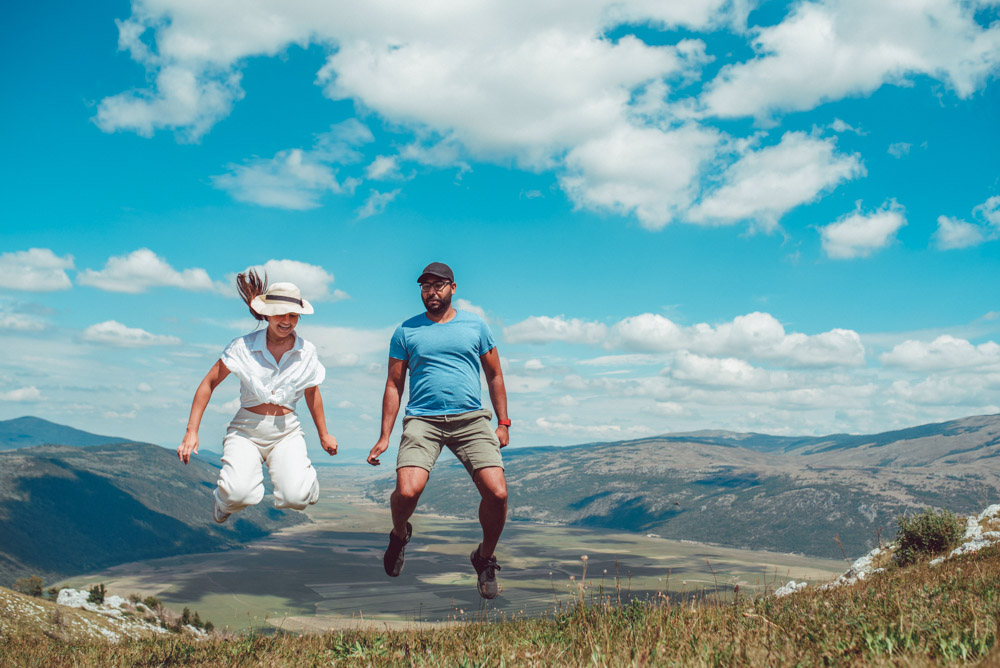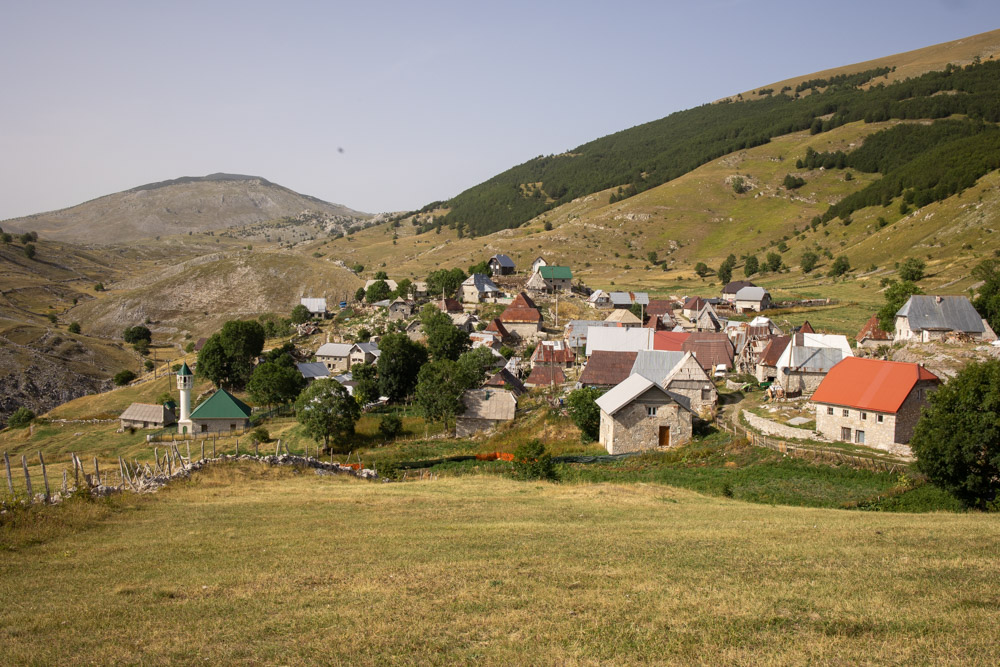Though I was born in Bosnia and Hercegovina (or BiH for short), my family and I fled when I was a child to escape the Bosnian War of the 1990s.
Lately, I’ve been learning more about the natural beauty and rich culture BiH has to offer. So, on my next trip back, I wanted to take the opportunity to really get to know the place beyond its grim history, and explore a more colourful and vibrant side.
Huzai and I were lucky to spend 6 weeks in the summer road tripping across the entire country, exploring everything from major cultural and historic hubs like Sarajevo and Mostar, to remote mountaintop villages like Lukomir, white water rafting down the scenic rivers, canyoning in pristine nature, hiking the Dinaric Alps, quad biking across the endless karst fields, and much more.

Warning: If you visit Krug Plateau, or any other remote areas, please do so with a professional guide or someone who is very familiar with the area. Example: in the photo above, it is not advised to venture down the hillside behind us as there are unexploded land mines. Signage is limited and can’t be relied on.
Outside of a couple of key points of interest, mass tourism hasn’t affected BiH for the most part. So we got to enjoy many of the activities without the crowds.
The trip left me truly in awe of the country’s beauty and touched by its peoples’ resilience and open hearts. As a tourist destination, it showed me that BiH is full of authentic adventures waiting to be had for anyone who is up for a challenge.
If you’re looking for a destination that’s rich in culture, history, art and beautiful nature, that is still relatively off the tourism radar, BiH is perfect.
As you plan your trip, this post is a rundown of the best adventures you don’t want to miss out on.
Nature
1. Go canyoning in pristine nature (exploring canyons by wading, climbing, swimming, rappelling, etc.)

Canyoning is an up and coming sport in the mountaineering sphere, in which you explore a wild canyon using any and all means necessary – climbing over large rocks and boulders, sliding down waterfalls, rappelling down sheer cliffs, jumping into bubbling natural whirlpools, and much more.
I had the opportunity to try it in the Hrcavka canyon. Buried deep in Sutjeska National Park, the Hrcavka is up to 200 metres deep and is one of Europe’s last conquered canyons. The canyon is still relatively wild and intact, so if you appreciate untouched nature, you are in for a treat.
While the activity certainly requires a basic level of fitness, the real challenge is mental. From a first-timer’s perspective, the entire experience is a mental marathon requiring you to defy your instinctual human fears over and over again in order to progress through the canyon.

Nevidio Canyon in Montenegro is another popular canyoning destination in the region. The canyoning experience at Nevidio is more accessible for various levels of physical ability and there are more companies offering tours in Nevidio, so it can get crowded in the peak season.
If you like a good adrenaline-fuelled challenge and appreciate pristine nature, you’ll love canyoning!
2. Hike around one of Europe’s last remaining primeval forests, Perućica
The old-growth rainforest, Perućica, also known the lungs of Europe, sprawls out over about 1400 hectares. It’s home to over 170 species of trees and bushes and over 1000 species of plants. The area’s significance to nature conservation is recognized by UNESCO due to the scale of its old growth forests.

Stop at one of the viewpoints around the forest for lunch and enjoy the incredible views.
3. See the wild horses of Livno

The ancestors of the wild horses found grazing on Cincar mountain were agricultural workhorses that were released by their owners in the midst of economic and war-influenced migrations. Shortly after the Yogoslav wars, there were about 50 horses roaming. Initially, only the strongest horses survived the harsh winters of the Krug / Kruzi Plateau. Today, their population has multiplied to over 700.
Go on a tour of Krug / Kruzi Plateau on Cincar to enjoy the unique karst fields and meet the wild horses that roam the lands.

4. Go white water rafting on one of the pristine, turquoise rivers
Tara
International Scale of River Difficulty: 3-5
The Tara river flows through Europe’s deepest canyon, the Tara canyon which is protected as a UNESCO World Heritage Site for its diverse ecosystem. It’s a real treat to explore, with tons of rapids, cascades, clearings and bridges, all set in pristine nature. The Tara river is also the country’s most popular rafting destination, so it does get crowded throughout the rafting season from April to October.
Una
International Scale of River Difficulty: 3-5 during the Štrbački Buk – Lohovo stage, and 2-3 during the Kostela – Grmuša stage
Serving as a natural border between BiH and Croatia, the Una river’s piercing turquoise green water, mesmerizing waterfalls and unspoiled nature lend it its reputation as the most beautiful river in the country. Local folklore has it that when the ancient Romans saw it for the first time, they cried “una” meaning “the only one” in reference to its beauty, and thus gave the river its name.

International Scale of River Difficulty: 3-4

Vrbas
International Scale of River Difficulty: 1-4
Insider tip #1: If you’re looking for an adrenaline rush, it’s best to plan your trip for the spring when the snow is melting into the rivers and the water levels are higher. If you’re looking for a more mellow experience, plan to go rafting during the summer instead.
5. Hike through the craggy mountains of Blidinje Nature Park

6. Chase the magnificent waterfalls
BiH is home to so many spectacular waterfalls, many of which you can swim under and around. Below are a few of my personal favourites – let me know yours in the comments!
Kravice Waterfalls

Pliva Waterfalls

Krupa Waterfalls

Štrbački Buk Waterfalls

Culture
7. Travel back in time to Lukomir, BiH’s most isolated mountain village

Lukomir is a semi-nomadic village perched close to 1500 metres high in the Dinaric Alps of BiH. Less than 20 families live there today, returning to the village in the summers to let their sheep graze the rich pastures, to work the land and to gather medicinal plants. Every year they must leave before the winter arrives and the conditions become inhospitable.
What’s so special about Lukomir is that the village and its people’s way of life has remained relatively unchanged since it was established over 600 years ago. This is mostly because the village is so remote, with only one narrow, macadam road that leads to it from Sarajevo.
Lukomir is the perfect place on your BiH trip to slow down and take it all in. In addition to ogling at the surrounding mountainscapes, you can hike along the breathtaking Rakitnica Canyon (the second deepest in Europe), try the local cuisine made with organic, farm-to-table ingredients from the village itself, learn about the local’s way of life and stargaze at night.
Insider tip #2: Lukomir is positioned on the back of Bjelašnica mountain, about a 2-hour drive from the capital of Sarajevo. In order to get there, you will need to drive towards the village of Umoljani (this section of the road is paved). After Umoljani, the road is mostly macadam i.e. unpaved. For the unpaved section you can either hike 8 – 9 hours to Lukomir, bike, take a 4×4, or try your luck with a font-wheel drive sedan. While it is possible to drive to the village in a sedan in dry conditions, it will take longer and your tires will certainly pay the price.
We went with a guide on a quad bike tour that started in Sarajevo, where we picked up our quads for the day and took them all the way up to village.
8. Explore Sarajevo’s strange and beautiful abandoned luge and bobsled tracks


9. Watch the sun set over Sarajevo from the Yellow Fortress
The Yellow Fortress (a.k.a. Yellow Bastion) is the perfect place to perch while watching the sun setting over Sarajevo’s pretty red roofs.
It’s about a 15 minute walk to the Yellow Fortress from the Bascarsija in the old town and it’s the perfect pre or post dinner activity!

10. Check out Livno’s picturesque old Ottoman bridge and cool off by the Duman natural spring
The 17th century Ottoman bridge in the Old Town of Livno connects the banks of the Bistrica River. Tucked scenically into the mountainside, it’s a great place to take a stroll and enjoy the Old Town’s quaint charm.


11. Dive from the from the Stari Most (“old bridge”)
Bridge jumping (i.e. jumping or diving head first 24 m from the arc of the Stari Most into the icy Neretva river below) is a long-standing tradition for the people of Mostar. The first recorded jump was in 1664, and the city has held annual diving competitions every year 1968. On most days, you can catch someone perfecting their plummet or perhaps jumping for the first time.
In fact, anyone who dares can jump off the bridge, but only under the supervision of the dive school, after getting their permission and completing a training session (the school is on the left side of the bridge in the photo below).
For the record, I’ve never jumped from the bridge nor do I have immediate plans to 🙂

12. Party it up at a medieval fortress in Banja Luka


History
13. Admire an iconic piece of Yugoslavian brutalist architecture in Tjentište

One of several otherworldly monuments that dot the BiH landscape, the Tjentiste War Memorial was built in the 1970s to commemorate the fallen Yugoslav Partisan soldiers from the Battle of Sutjeska in 1943 during WWII against the Nazi offensive.
There are different interpretations regarding what the structure symbolizes. According to the designer Miodrag Živković, it represents wings of victory which are overcoming the oppression and hate forced upon the surrounding hills by the German and Italian occupying armies.
It was important for the sculpture to be positioned such that it could be seen from across nearly the entire Sutjeska Valley. So, it was made on a man-made hilltop.
The monument is strange, majestic and definitely a must-see.
14. Walk the Sarajevo Tunnel at the War Tunnel Museum
Sarajevo was under siege by Serb forces from 1992 to 1996, the longest blockade of any capital in modern warfare, subject to daily shellings and sniper attacks for almost 4 years. The Tunnel of Hope was built in 1993 by the BiH army, connecting besieged Sarajevo to a free Bosnian neighbourhood outside of the siege line, serving as a lifeline to the people trapped inside.
The War Tunnel museum is a an engaging way to learn about an important part of the city’s history – you should definitely check it out!


15. Explore Tito’s secret Cold War era nuclear bunker
In the town of Konjic, you’ll find an inconspicuous white building that looks just like a typical Balkan holiday home nestled in the mountainside of Bjelašnica Mountain.
Inside, a secret door leads to a tunnel that descends 200 metres through the bedrock, to a series of airtight blast doors. Past the doors is an underground complex designed to withstand a direct 20 kilton nuclear blast and sustain about 350 government leaders for at least 6 months.
As the nuclear arms race between the Soviet Union and the West was heating up after WWII, former Yugoslavia’s president Josip Broz Tito ordered that the top-secret facility be built, spending about $4.6 billion USD (the equivalent of $20 billion today) over 15 years. Construction was completed in 1979, one year before his death.
The nuclear shelter was ordered by the Yugoslav People’s Army to be destroyed for fear of being captured by the BiH People’s Army. However, Colonel Serif Grabovica, who was in charge of the destruction refused to do it
Today, the facility is open for visitors to learn about its history and admire its architecture and design.





